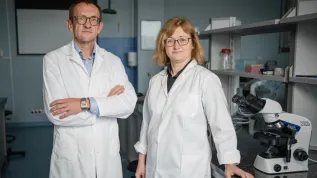
The first proton therapy centre in our region of Europe will begin operations in Bronowice in Kraków in the third quarter of 2015 - as announced at a press conference in Warsaw.
The centre is being established in the Cyclotron Centre Bronowice in Kraków, a branch of the Institute of Nuclear Physics PAS. Last Wednesday, a letter of intent was signed by the director of the Institute of Oncology in Warsaw, Prof. Krzysztof Warzocha and director of the Institute of Nuclear Physics PAS, Prof. Marek Jeżabek.
Prof. Warzocha told reporters that proton therapy is the latest treatment method for tumours located in sensitive areas where the removal with previously available methods is impossible or exposes the patient to serious complications. "This therapy is used only in a few centres in the world, mainly in the United States and Western Europe. China has only one such centre" - he said.
Prof. Jeżabek added that in Bronowice proton therapy is used in patients with melanoma of the eye. This is the most common cancer of the inner eye that occurs in adults; accounting for 20 percent of all melanomas. So far, in our country about 100 patients with this cancer have been treated with this method.
"Currently, we are preparing two proton therapy stations. One, partly already running, will treat cancer of the eye. The second, which will be built by the end of the third quarter of 2015, will be used to remove tumours located anywhere in the body" - said the director of the Institute of Nuclear Physics PAS.
He added that at least 350 patients per year will be treated at each station, a total of 700 patients. In his opinion, it should address the immediate demand for this method of treatment in Poland.
National radiation oncology consultant Prof. Rafał Dziadziuszko said that thanks to these stations, patients will not have to be sent abroad for proton therapy. "Currently, the National Health Fund refers dozens of patients every year to the US and Western Europe for this treatment" - he told PAP. And the treatment is expensive. In the United States the treatment of one patient with this method costs 80-90 thousand dollars.
Director of the Institute of Oncology in in Kraków, Prof. Jerzy Jakubowicz hopes that proton therapy performed in our country will be financed by the NHF. "We offered a refund at the level of 150 thousand zlotys" - he said. For the treatment of ocular melanoma the NHF pays 55 thousand zlotys.
"Proton therapy saves the eye of a patient with melanoma of the eye. He will not see the same way as before detection of the disease, but with this method he can keep the eye and the ability to see" - Prof. Jakubowicz said in an interview with PAP.
Director of the Institute of Oncology in Gliwice, Prof. Bogusław Maciejewski emphasized that this is the main advantage of proton therapy. "It is not a wonderful method of treatment of malignant tumours, for which there was no treatment before. It only allows to operate difficult to access tumours, the treatment of which with other methods is associated with serious complications or mutilation of the patient. Therefore, it is of particular use in children" - he said.
In proton therapy, proton radiation is used for irradiation of malignancies. It has the advantage that allows to focus the optimal dose on the tumour itself, sparing healthy tissue located closer to the surface (due to the so-called inverse dose profile resulting from the Bethe-Bloch formula).
President of the Polish Society of Surgical Oncology, Prof. Piotr Rutkowski told PAP that conventional photon radiation penetrates all the tissues of the irradiated spot. Therefore, it can not be used for tumours located too deep or close to critical tissues and organs.
"In these most sensitive areas of the body, proton therapy is more suitable. It can be used to remove tumours of the head and neck, around the spinal cord and pelvis" - explained Prof. Rutkowski. The effectiveness of this method is estimated at 95-98 percent with regard to the possibility of the removal of neoplastic lesions.
In addition to treatment, the Cyclotron Centre Bronowice will also carry out research. "We will pursue it mostly at night and on weekends, when the patients do not use the devices" - said director of the Institute of Nuclear Physics Prof. Jeżabek. Modern cyclotron is being built since 2011 under the Programme Innovative Economy.
PAP - Science and Scholarship in Poland, Zbigniew Wojtasiński
zbw/ mki/
tr. RL













